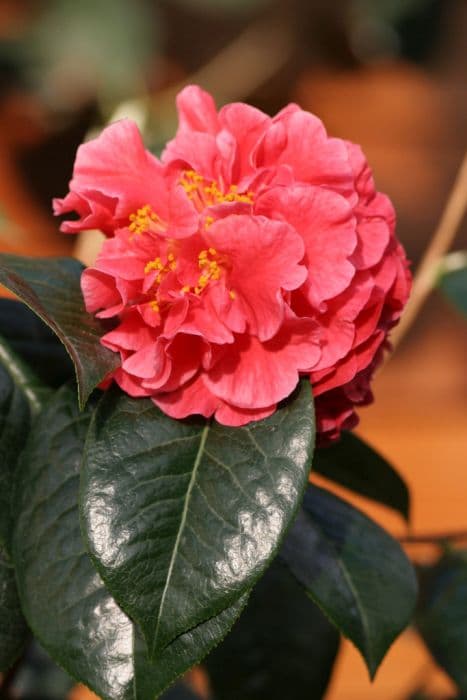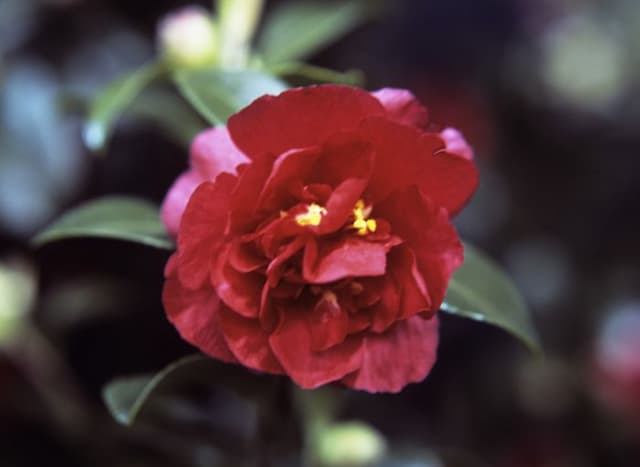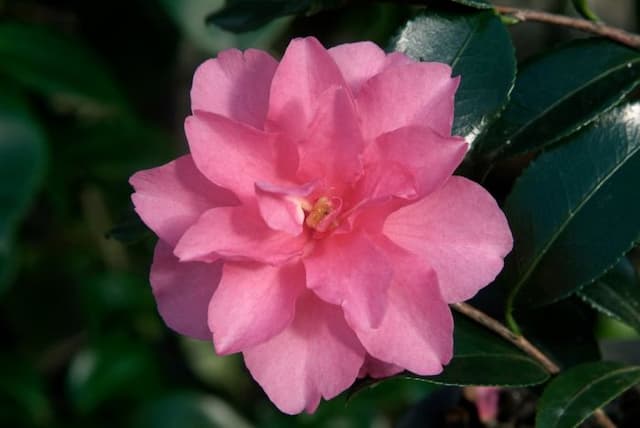Camellia Camellia 'Quintessence' (japonica × lutchuensis)

ABOUT
The Camellia 'Quintessence' is an ornamental plant well-loved for its aesthetic qualities. The flowers of this camellia are delicate and have a soft, creamy-white hue. They feature a rich, flush of pale pink at the edges, producing a gentle gradient of color that adds to their allure. The blossoms have a subtle, sweet fragrance, reminiscent of that found in high-quality floral perfumes, an attribute inherited from one of its parent plants. The petals arrange themselves in an overlapping fashion, conferring a sense of fullness and layering that offers an exquisite visual texture to the blooms. The flowers are quite resilient and maintain their composure even under the weight of raindrops, which can add a glistening effect like that of a crystal veneer on a sunny day. Typically, the blooms are moderate in size and they appear profusely on the plant, creating a striking contrast against the backdrop of glossy, deep green leaves that are consistent year-round. These evergreen leaves present a classic camellia profile—oval with a slightly serrated edge and a leathery texture that enables them to withstand various weather conditions. Their bold color and sheen play a prominent role in establishing the plant's visual presence even when it is not in bloom, ensuring that the Camellia 'Quintessence' remains a compelling feature in any garden setting throughout the seasons.
About this plant
 Names
NamesFamily
Theaceae.
Synonyms
Camellia, Japanese Camellia, Miniature Camellia, Fragrant Camellia.
Common names
Camellia 'Quintessence' (japonica × lutchuensis).
 Toxicity
ToxicityTo humans
Camellia 'Quintessence', commonly known as camellia, is not typically considered to be toxic to humans. In general, the Camellia genus, which includes several species and hybrids, is not listed among the plants known for causing poisoning when ingested. Consequently, accidental ingestion of camellia leaves or flowers is unlikely to result in serious harm or significant symptoms of poisoning in humans. However, it's always prudent to avoid eating plant parts unless they are known to be safe for consumption, and to keep an eye out for any unusual reaction if ingestion happens accidentally.
To pets
Camellia 'Quintessence', commonly known as camellia, is not widely recognized as a toxic plant for pets. This means that if pets, such as cats and dogs, ingest parts of this plant, they are unlikely to experience significant symptoms of poisoning. However, it is always best to prevent your pets from eating plants not intended for their consumption, as individual animals may have unique sensitivities, and ingestion of non-food items can sometimes lead to gastrointestinal upset or other issues unrelated to toxicity. If you notice any adverse reactions after your pet has ingested part of a camellia plant, consult with your veterinarian.
 Characteristics
CharacteristicsLife cycle
Perennials
Foliage type
Evergreen
Color of leaves
Green
Flower color
White
Height
2-3 feet (0.6-0.9 meters)
Spread
2-3 feet (0.6-0.9 meters)
Plant type
Shrub
Hardiness zones
7-9
Native area
Japan
Benefits
 General Benefits
General Benefits- Compact Growth: Camellia 'Quintessence' has a smaller, bushier growth habit which makes it well-suited for smaller gardens or as a container plant.
- Attractive Flowers: It features beautiful, fragrant flowers which can enhance the aesthetic appeal of any garden.
- Long Blooming Season: The blooming period extends from fall to spring, providing color and interest during the duller months.
- Drought Tolerance: Once established, it has a degree of drought tolerance, making it suitable for regions with dryer climates.
- Minimal Maintenance: It requires relatively low maintenance, needing only occasional pruning to maintain shape and remove dead or diseased wood.
- Pest Resistance: Camellia 'Quintessence' tends to be resistant to many pests, reducing the need for chemical treatments.
- Evergreen Foliage: It retains its leaves year-round, providing continuous greenery and structure in the garden.
- Shade Tolerance: The plant can tolerate partial shade, making it a versatile choice for different garden locations.
- Soil Adaptability: It can adapt to a variety of soil types, although it prefers well-drained, acidic soils.
 Medical Properties
Medical PropertiesThis plant is not used for medical purposes.
 Air-purifying Qualities
Air-purifying QualitiesThis plant is not specifically known for air purifying qualities.
 Other Uses
Other Uses- Culinary decoration: The blossoms of Camellia can be candied and used as elegant decorations on cakes and pastries.
- Botanical art: Camellia flowers, due to their beauty, are a popular subject in botanical illustration and watercolor paintings.
- Hair adornment: In some cultures, the flowers of Camellia are worn in the hair during special ceremonies or traditional dances.
- Natural dye: The petals can be used to produce natural dyes for fabric, offering a range of colors from pinks to reds.
- Fragrant oils: Camellia flowers can be used to infuse oils with their fragrance for use in homemade perfumes or scented candles.
- Photography: The striking blossoms are often photographed for their aesthetic value and used in photography projects or workshops.
- Tea ceremonies: In some Asian cultures, Camellia flowers may be incorporated as part of the setting or decor in traditional tea ceremonies.
- Pressed flower craft: The blooms can be pressed and preserved to be used in crafting, such as in scrapbooking, card making, or decoupage.
- Floral baths: Petals can be added to bathwater for a luxurious, scented bathing experience.
- Gardening education: Camellia plants are used in educational settings to teach about plant propagation, pruning techniques, and flower anatomy.
Interesting Facts
 Feng Shui
Feng ShuiThe Camellia is not used in Feng Shui practice.
 Zodiac Sign Compitability
Zodiac Sign CompitabilityThe Camellia is not used in astrology practice.
 Plant Symbolism
Plant Symbolism- Adoration and Devotion: The Camellia flower often symbolizes deep adoration and devotion, and is sometimes exchanged between lovers to express these sentiments.
- Perfection and Excellence: Thanks to its impeccably formed petals and overall beauty, the Camellia represents the strive for perfection and excellence.
- Enduring Passion: With its rich color and long-lasting blooms, the Camellia can signify enduring passion and romantic persistence.
- Respect and Admiration: In some cultures, giving a Camellia is a way to show respect and admiration towards someone, acknowledging their accomplishments with grace.
- Longevity and Faithfulness: Because this plant can live and thrive for many years, it is also seen as a symbol of longevity and faithfulness in relationships.
 Water
WaterFor a Camellia 'Quintessence', which is a hybrid Camellia, water should be applied thoroughly to the root zone when the top inch of soil feels dry to the touch. This usually equates to watering once a week, but the exact frequency depends on climate, soil type, and weather conditions. During the growing season, aim to provide at least one gallon of water per week, adjusting as necessary for rainfall and temperature. In the winter, reduce watering but ensure the root ball doesn't dry out completely. Avoid overhead watering to minimize leaf wetness and potential disease issues.
 Light
LightCamellia 'Quintessence' thrives best in partial shade to filtered sunlight. It should be protected from intense afternoon sun, which can scorch the leaves, and strong winds. An ideal spot would be under the high, dappled shade of taller trees or on the north or east side of a building where it will receive bright, indirect light.
 Temperature
TemperatureCamellia 'Quintessence' prefers temperatures that range between 50°F and 85°F. This hybrid Camellia can tolerate minimal frost and survive in temperatures as low as 20°F, but prolonged exposure to extreme cold can be damaging. The highest temperature tolerated is around 90°F before the plant starts to experience stress.
 Pruning
PruningPruning a Camellia 'Quintessence' is mainly done to maintain its shape and remove any dead or damaged branches. It’s best to prune immediately after flowering ends in the spring, as pruning later can remove next season's buds. Thin out dense growth to improve air circulation and light penetration, encouraging healthier growth. Annual pruning is often sufficient for this plant.
 Cleaning
CleaningAs needed
 Soil
SoilCamellia 'Quintessence' thrives in acidic soil with a pH of 5.5 to 6.5. The best soil mix consists of 2 parts peat moss or ericaceous compost, 1 part perlite, and 1 part pine bark fines to ensure good drainage and aeration while retaining moisture.
 Repotting
RepottingA Camellia 'Quintessence' typically needs to be repotted every 2 to 3 years, in the spring before the growing season begins. Use a container only slightly larger than the previous one to avoid root rot.
 Humidity & Misting
Humidity & MistingCamellia 'Quintessence' prefers high humidity levels ranging from 50% to 80%. To maintain these conditions, especially indoors, consider using a humidifier or placing the pot on a tray of wet pebbles.
 Suitable locations
Suitable locationsIndoor
Place in bright, indirect light and maintain high humidity.
Outdoor
Plant in partial shade with shelter from strong winds.
Hardiness zone
7-9 USDA
 Life cycle
Life cycleThe Camellia 'Quintessence' begins life as a seed, which after a period of dormancy, germinates in favorable conditions of warmth and moisture. The seedling emerges and develops into a juvenile plant with a small root system and several leaves, entering a vegetative stage where the primary focus is on growth and establishment. As it matures, the Camellia plant enters a period of flowering, typically signaled by cooler temperatures in fall or winter, during which it produces fragrant blooms that attract pollinators, though many Camellias are self-fertile. After pollination, fertilization occurs and the plant develops seed pods which eventually dry and open to release seeds, completing its reproductive cycle. Alongside this, the Camellia continues its vegetative growth, often for many years, as it is an evergreen shrub and can live for a considerable time. If conditions remain favorable, this cycle of growth and reproduction can continue annually, with the plant potentially achieving substantial size and an extensive root system.
 Propogation
PropogationPropogation time
Spring-Early Summer
Propogation: The most popular method of propagating Camellia 'Quintessence', commonly known as camellia, is through semi-hardwood cuttings. This process typically takes place during late summer. To propagate, one selects healthy semi-hardwood stems from the current year's growth and cuts a section about 4 to 6 inches (about 10 to 15 centimeters) long, just below a leaf node. The leaves on the lower half of the cutting are removed, and the cut end is dipped in a rooting hormone to increase the chances of successful root development. The treated cutting is then planted in a mixture of peat and perlite, ensuring the leaf nodes where the lower leaves were removed are buried. The cutting should be kept moist and placed in a warm, well-lit area, but out of direct sunlight. It's essential to maintain high humidity around the cutting, commonly achieved by covering it with a plastic bag or placing it in a propagator.









